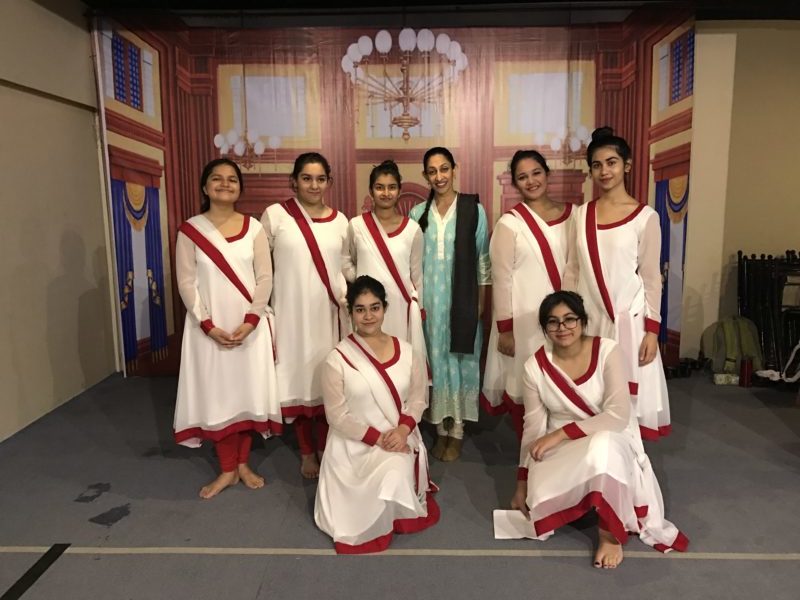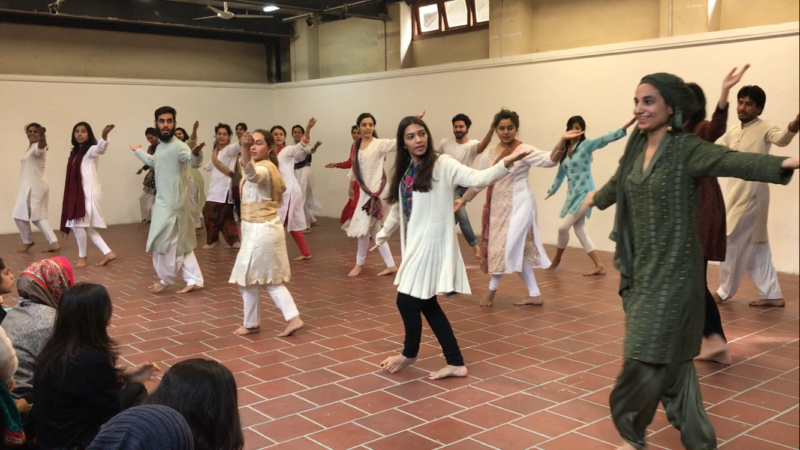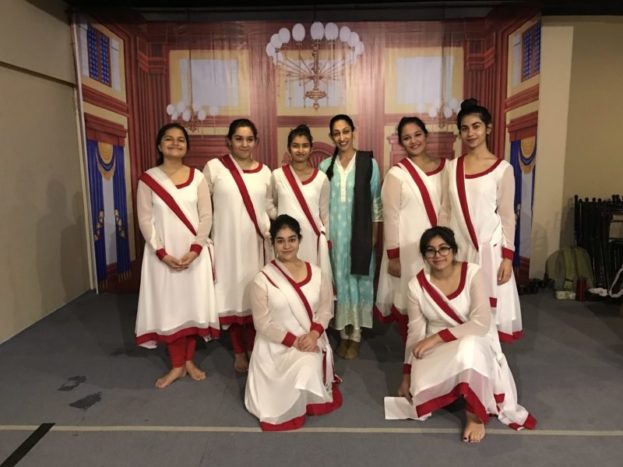
EDITORS NOTE: In this ongoing series for In Dance Farah Yasmeen Shaikh writes about her experiences as a Pakistani Muslim-American woman Kathak artist and her work teaching and performing in Pakistan. Article #1: How Politics and Power Shaped Dance in Pakistan can be found in the December 2016 issue and Article #2: Our World in Constant Motion in the March 2017 issue.
When I first titled this series of articles, I was reflecting on how my work in Pakistan has allowed me to “gain perspective” and “shift [my own] perceptions,” as I had my own prejudices and assumptions about the environment, how I would fit into it, and what the overall response would be to performing and teaching there. I went into this work with my own personal goals of challenging myself to represent an art form and my training in it, my personal background as an American born to Pakistani immigrants, and to own my identity as a Muslim, but being fully aware that I may not be seen as such due to my relatively progressive lifestyle. Personally and professionally, so much was at risk. I’m proud to have been able to abandon my own doubts about having a presence in Pakistan to now truly feeling like I can comfortably call the country a second home. Having completed four trips in just one year, and with plans to continue to perform and teach in Pakistan, my increased awareness and comfort, and thus experience of working in this environment positions me to further embrace the previously unforeseen responsibility of bridging the gaps that we innocently and often unknowingly create through our misconceptions.
While working in Pakistan, and sharing it through various mediums (social media, these articles) a catalyst has been put in place for many unexpected conversations and responses I’ve received about my experiences. In Pakistan itself, it has been a matter of breaking through the perceptions of dance – ones of stigma, of being un-Islamic; of Kathak as an art form that some see as “Hindu” dance which due to continued animosity between India and Pakistan some view Kathak as not having an appropriate place in Pakistan. This has happened most frequently through my experiences teaching in Pakistan.

In some settings, students involuntarily took my class as it was a requirement put in place by their educational institution or department. For the most part, students were open and welcoming to this experience, but there were some who expressed hesitation and resistance, mainly due to their own religious interpretations of how dance would be disrespecting their belief system, and/or if they felt an aspect of what I was teaching was displaying too much reverence to aspects of Hinduism. Navigating these sensitivities while simultaneously being true to the integrity and history of Kathak has been challenging to say the least, but also the source of important dialogue and lessons on how to teach in such environments without isolating or ostracizing myself or the students. I’ve also had the honor and huge responsibility of quite often offering the very first dance class that many of the participants had ever taken – ever. Keep in mind, most of my work has been with high school and university level students.
I know I’m not alone in thinking, as my GuruJi, Pandit Chitresh Das, used to say “Arts and culture bring peace and harmony.” However, imagine being in a situation where I could potentially reinforce one’s prejudice against dance, its history, or its cultural and religious influences, depending on my approach to teaching and reaching the students. The greatest joy has come from numerous accounts of transformation from students who had expressed hesitation in taking the class for reasons described above, to at the end of their time with me sharing how much they “loved” the experience.
Here is one such sentiment from a student at a university in Karachi:
“This is the first time I’ve actually danced in my life. Before that I used to see people dance, but it never touched my heart until now. It made me feel more close to myself and I feel more confident in myself.” —Shahzadi.
And for those who of their own desire had enrolled in one of my classes, it has been an honor to not just introduce them to Kathak, but to instill in them the desire to have more such experiences.
“The various movements we learned improved our posture and increased our confidence, especially in the way we walk and talk to others. And the history surrounding Kathak enlightened us about our own [culture]”—Aleezeh and Natalia, high school students in Karachi.
I realize that I now have a unique vantage point that I’ve obtained through a deeper understanding of Pakistani politics over the decades, the country’s ongoing (strained) relations with India, and the numerous positive developments Pakistan has undergone—and the parallels of all of this to that of what we are witnessing take place around the world. I could have never predicted that working abroad would happen at a time when our global state of affairs, and specifically the political chaos that has developed in the US, would make my work in Pakistan, and my upcoming artistic presentation, strangely and somewhat sadly, relevant.
In the fall of 2016, I received funding from the CA$H Grant to support my upcoming work, The Partition Project, focused on the 1947 Partition of India and Pakistan. Based on the stories and testimonials from witnesses of Partition, this will be a collaborative presentation with EnActe Arts and the 1947 Partition Archive, told through dance, music, theater and multimedia (premiering at Z Space in San Francisco, January 2018). A pivotal time in the history of South Asia, the Partition is when British rule ended in India and a divided India and Pakistan was based on religious lines, with Pakistan created as an Islamic nation. During the transfer of power, and the mass migration to the other side of these newly formed borders, 15 mil- lion people became homeless, making it the world’s largest mass human displacement (see footnote #1).
Creating work on such a heavy topic – one that is only 70 years old, and that still has a huge impact on the neighboring countries of India and Pakistan with regards to their own relationship as well as their standing with the rest of the world – requires me to find as many opportunities as I can to connect and feel the historical side of Partition as well as its present day relevance.
With the support of the grant, during my trip to Pakistan in January 2017, I made plans to travel from Karachi (the city where I spend most of my time in Pakistan) to go north to Lahore. Just outside Lahore is a small town, Wagah, which serves as a transit terminal for goods and a railway station between Pakistan and India. It lies on the old Grand Trunk Road between Lahore, Pakistan and Amritsar, India. My hope and intention in visiting the border was to absorb, reflect on, and document through photos and video. Here is my account on social media of my experience:
“Yesterday my daughter and I went to the Wagah border of Pakistan and India. I had heard of the pomp between the rangers from each country, but needed to witness what it felt like to visit this visible and physical separation between two countries that not too long ago were one.
The experience was overtaken by what I can compare to a school rally. Attendees from either side were trying be louder than the other. The rangers were competing by kicking higher than the other and puffing their chest broader than their opponent. I tried to mute the cheers and clapping, and blur the flags waving and instead focused on the lack of sentimentality.
High security seemed to be the only thing reminiscent of the state of relations between the countries. But where were the hardcore facts of Partition, of the tragic human displacement and unprecedented loss of lives in such a short period of time? Where was the account of how people migrated across on foot or by train in 1947, and how families were forced to leave their land, belongings, businesses, to never be able to return to their birthplace and the only homes they had known? Instead we watched men in embellished uniforms perform goofy routines of high kicks and awkward marching sequences.
There was a moment in this comedic display in which a handshake from representatives of each country takes place. But that too was all for show as the gates opened for the human contact, but were quickly closed again once the backs were turned.
One beautiful moment: seeing the flags of Pakistan and India almost become one as they crossed each other on their respective strings.
I know we cannot rewrite history, but when are we going to own it? When are we going to dissect and break down the many ways in which this tragic history continues to divide us? When are we going to rise above and not let a handshake just be for show?
The hope is that The Partition Project will at least provoke open, honest dialogue about our history, how it continues to shape us, and sadly not for the better.”
As I continue to reflect on my work as an artist in this tumultuous world, I am grateful for the perspective that I gain through doing work internationally. On a daily basis we bear witness to populations from around the world having to (sometimes forced, sometimes by choice) flee their homelands, and then observe the various governments from other countries determine who they will “welcome,” let alone who each will allow to simply visit or return to the places they now call home. I am struck by how many examples we have right in front of us—Pakistan and India being one of them—of how conservative and oppressive political regimes can take populations back hundreds of years in thought and practice. And how we can look to the fallout from such examples to guide in decision making that should and could so easily be based on humane practice that will not result in racial or religious prejudice, violence, displacement, loss of lives and degradation of culture.
One of the highlights from my January 2017 trip was an invitation to perform in Lahore at Faiz Ghar, the home of the late renowned Urdu poet, revolutionary and human rights activist, Faiz Ahmed Faiz.
It was a tremendous honor to perform here, and timely yet again, as his work was often a response to political oppression. One of his works in particular comes to mind as I think of him, his vast contributions, the poignancy of his words even today. This piece is titled Hum Dekhenge, meaning “We will see.” Originally in Urdu, this is an English translation of an excerpt from the poem:
We will see
It is certain that we too will see
When the cruel mountains of injustice Will blow away like cotton-wool Beneath the feet of (us) the oppressed This earth’s heartbeat will pound And above the heads of the rulers Lightning will crackleWe will see


